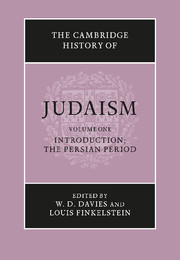Book contents
- Frontmatter
- INTRODUCTION
- THE PERSIAN PERIOD
- 4 The Persian empire and the political and social history of Palestine in the Persian period
- 5 The archeology of Persian palestine
- 6 Hebrew and Aramaic in the Persian period
- 7 The Jewish community in Palestine in the Persian period
- 8 Prophecy and Psalms in the Persian period
- 9 Wisdom literature in the Persian period
- 10 Jewish religious life in the Persian period
- 11 Persian religion in the Achemenid age
- 12 Iranian influence on Judaism: first century B.C.E. to second century C.E.
- 13 The Diaspora
- Bibliographies
- Chronological Table
- Index
- References
11 - Persian religion in the Achemenid age
from THE PERSIAN PERIOD
Published online by Cambridge University Press: 28 March 2008
- Frontmatter
- INTRODUCTION
- THE PERSIAN PERIOD
- 4 The Persian empire and the political and social history of Palestine in the Persian period
- 5 The archeology of Persian palestine
- 6 Hebrew and Aramaic in the Persian period
- 7 The Jewish community in Palestine in the Persian period
- 8 Prophecy and Psalms in the Persian period
- 9 Wisdom literature in the Persian period
- 10 Jewish religious life in the Persian period
- 11 Persian religion in the Achemenid age
- 12 Iranian influence on Judaism: first century B.C.E. to second century C.E.
- 13 The Diaspora
- Bibliographies
- Chronological Table
- Index
- References
Summary
A key point in the study of Achemenid religion is the date of Zarathushtra, over which scholars have been long divided. One group judged the issue on the evidence of the Gathas, the seventeen hymns attributed to the prophet. These are composed in the oldest known stage of ‘Avestan’ (the eastern Iranian language of the Avesta or Zoroastrian holy texts), and have their closest linguistic affinities with the Rig-Veda. The social and world outlook implicit in them is correspondingly archaic, and so it was deduced that Zarathushtra must have lived about 1000 b.c.e. or even earlier.
The other group of scholars laid weight on a date to be derived from a late chapter of the Bundahishn. This is a composite Pahlavi work, that is, it belongs to the secondary Zoroastrian literature preserved in Pahlavi or Middle Persian, most of which was written down between the fourth and tenth centuries c.e. The chapter in question contains king-lists designed to fill out a schematized world-history; and it gives a place to Kavi Vishtaspa, Zarathushtra's royal patron, which sets the prophet's floruit at ‘258 years before Alexander’. This is the date expressly recorded, as that assigned by the Zoroastrians to their prophet, by the early Islamic scholars al-Mascudi and al-Biruni. Its modesty and apparent precision made it seem credible to some modern scholars, who accordingly assigned Zarathushtra to the sixth century b.c.e., supposing him thus to have been an eastern Iranian con temporary of the Achemenid Cyrus the Great.
Information
- Type
- Chapter
- Information
- The Cambridge History of Judaism , pp. 279 - 307Publisher: Cambridge University PressPrint publication year: 1984
References
Accessibility standard: Unknown
Why this information is here
This section outlines the accessibility features of this content - including support for screen readers, full keyboard navigation and high-contrast display options. This may not be relevant for you.Accessibility Information
- 1
- Cited by
